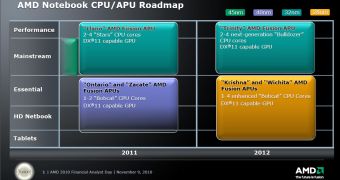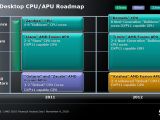Since Intel has reaped a fair share of profits form its mobile CPUs, and with AMD having joined this fray just months ago, the latter now plans to become more aggressive in this area and plans to use Fusion as its main weapon.
As end-users know, Fusion is a technology which allows AMD to create multi-core processors with on-die graphics.
What these so-called APUs (accelerated processing units) have as an arguable major advantage over Intel's own CPUs with integrated graphics is support for DirectX 11.
Since the laptop market has been more or less flourishing, AMD appears to have decided to put more effort in its mobile processor plans.
As such, according to its most recent announcement regarding roadmaps, major steps towards securing a larger portion of the notebook front will be made in 2012.
Within the next two years, AMD hopes to move to the 28nm manufacturing process, on which the Krishna and Wichita APUs will be constructed, slated for 2012.
These two will be successors to the Ontario and Zacate units that their maker will bring out and promote starting next year.
The Ontario and Zacate will use the 40nm manufacturing process and will be accompanied by another set of chips, codenamed Trinity, which will cater to the mainstream and entry-level markets.
"AMD's business model has consistently delivered operating profits this year, while the strength of our platform offerings drove continued expansion of our customer base," said Dirk Meyer, AMD president and CEO.
“The industry is at an inflection point, with users demanding technology that is more immersive and interactive,” he added.
"With our upcoming AMD Fusion APUs combining our DirectX 11-capable graphics processors and next-generation microprocessors on a single chip, we are poised to lead the industry's next computing era with richer, more vivid digital experiences," Meyer went on to saying.

 14 DAY TRIAL //
14 DAY TRIAL // 
